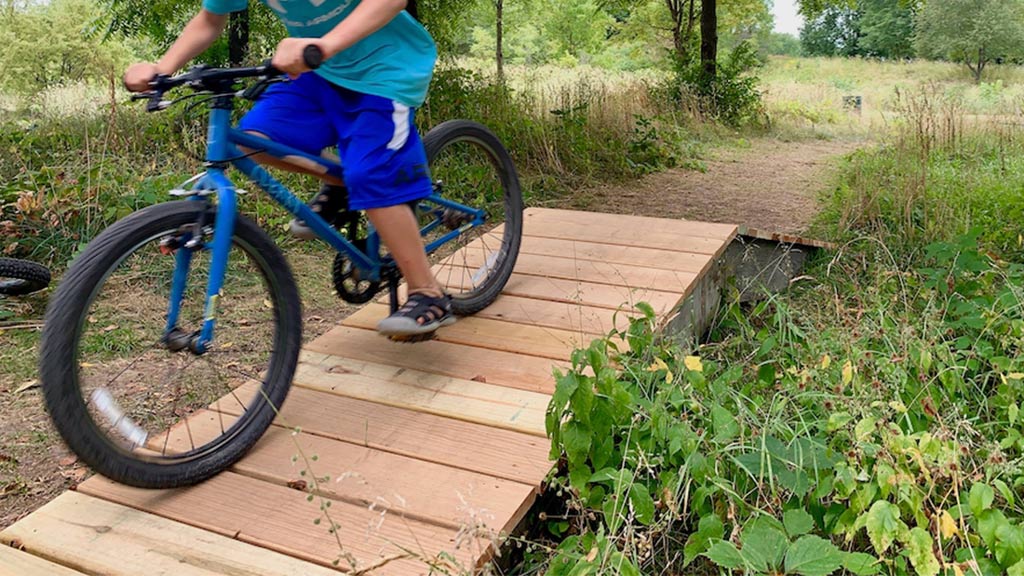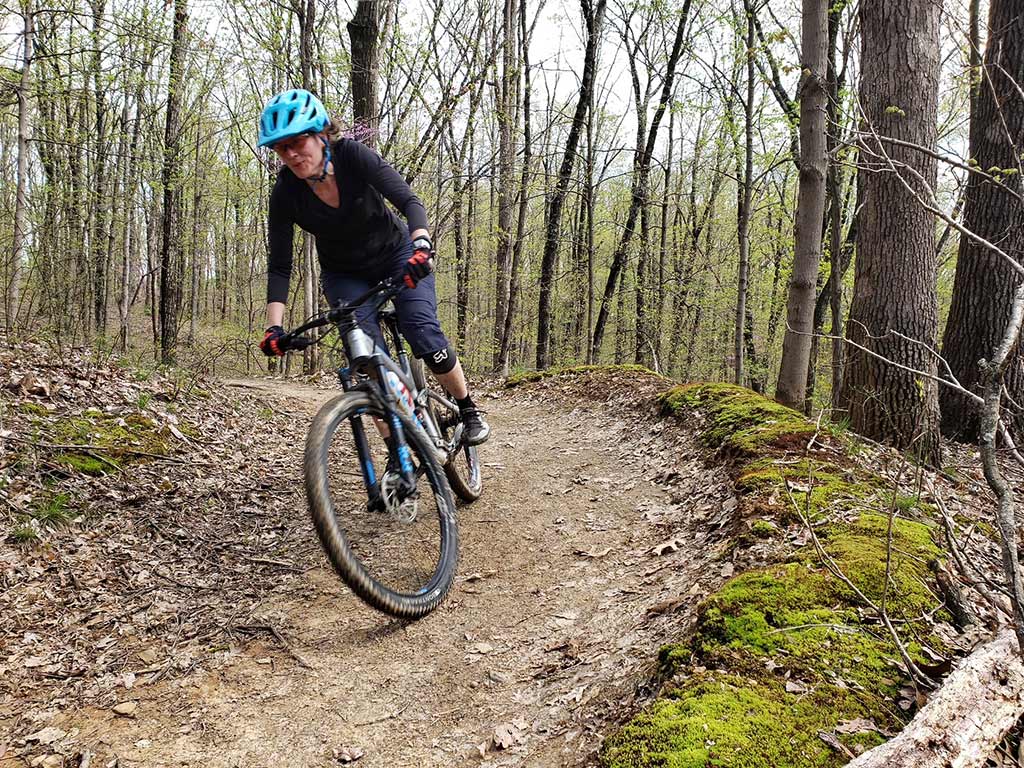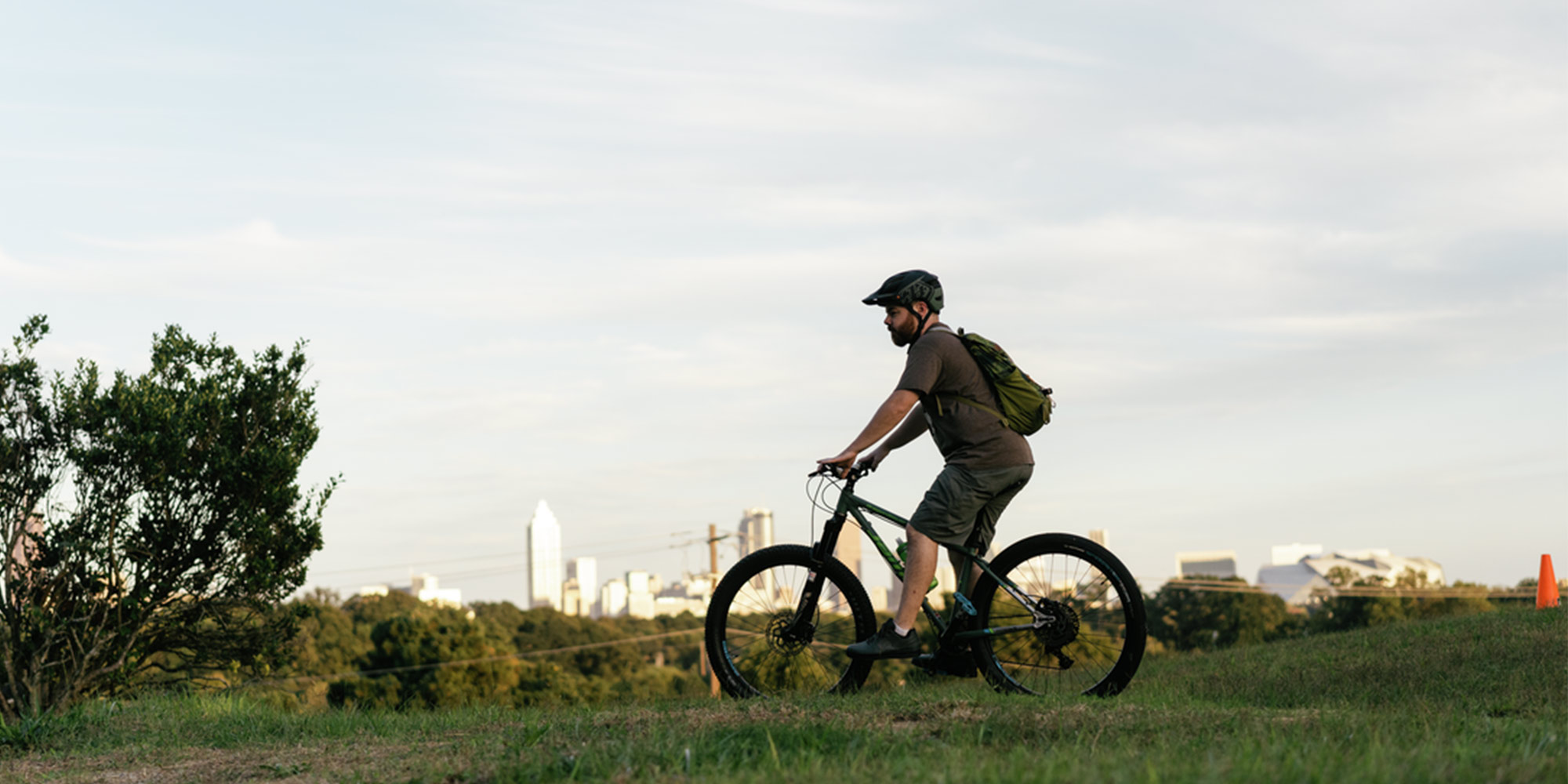Henry Aiyenero works at One City School, a charter elementary on the south side of Madison, Wisconsin. The school serves a diverse group of underprivileged students. When the pandemic hit last spring, classroom life switched to Zoom. No longer could Aiyenero sit beside the 6- to-10-year-olds and help them if they were struggling with a lesson. When they’d start to fidget, he cajoled them with his vibrant tenor to join him in a set of jumping jacks and air squats.
Then, last summer, a singletrack trail appeared almost overnight adjacent to the campus. That gave Aiyenero an idea about how to reconnect with those restless students. He posted on the school’s Facebook page: Did parents want to bring their kids for a Saturday morning, socially distanced bike ride?
Aiyenero, who grew up in Lagos, Nigeria, got his first bike when he was about five. “It wasn’t a bike for me. There was one bike for three kids, and it was handed down,” he says. Ever since, he adds, he has understood the magic of riding. “It’s freeing for a child. It’s an adventure for life.”

That first day, five children, some on training wheels, showed up to ride the simple ribbons of stacked trail that had been cut through the prairie grass on school property and at the 11-acre Aldo Leopold Park next door. By the end of the summer, 30 or more kids showed up every weekend. Aiyenero fixed a boombox to his handlebars and led the charge around the loops, a Pied Piper on two wheels. Soon, he scoured neighborhood garage sales, buying up bikes for kids whose families couldn’t afford them. Children began to arrive even before the 7 a.m. ride starts to shred the singletrack. When their parents came to fetch them hours later, they’d still be pedaling. Moms and dads began to join in, too.
Trails you can access more readily
Madison is ringed by mountain biking trails, but a cyclist has to drive to nearly all of it. City officials want to change that by building more singletrack in the city. The efforts have only just begun. The trails by Aiyenero’s school are the first in a years-long project to develop the Madison Bicycle Adventure Trail Network. The goal is to create basic singletrack, pump tracks and skills challenges in city parks, so that children in particular can have fun while learning how to handle a bike well. Officials also hope to link together the playgrounds with dirt singletrack, like pearls on a string, so those green oases can be accessed more readily by riders of all ages. Many of those parks now are underused. The hope is that they again become magnets for kids (and adults) of every economic level. Officials hope the new trails will encourage commuting, too.
Madison already has about 75 miles of multi-use paths as well as some bike-lane infrastructure. But those paths don’t foster play or exploration, says Mike Repyak, a landscape architect and planner with the non-profit International Mountain Biking Association (IMBA). The advocacy group gave Madison grant money for project planning. “You put in trail or a pump track or just some small skills challenges in a city park and kids will start riding and stick with it through life,” says Repyak, a Madison native.
Close to home biking
IMBA has shifted its attention over the years to such efforts in urban areas and other communities, not just backcountry destinations. Not only do they reduce the reliance on cars—including by cyclists who simply want to go biking—but also because closer-to-home trails ‘flatten’ the sport and make it available to more people, according to the group. The efforts also allow urban dwellers to experience green places in the city. Birders and hikers can use the trails, too. And birds and other wildlife use the greenways to move through the urban jungle. It all adds up to a respite in a jangly world.
Cities like Knoxville, Tennessee, and Atlanta today are working with armies of volunteers and trail crews to weave their own urban trail systems for mountain biking. Many of the efforts are works in progress. Some face pushback—sometimes from land managers or developers. But they underscore the vision at work, and the possibilities for adventure for a city-living child, which, as Aiyenero knows, can be transformative.

Louisville, Kentucky
Louisville locals don’t have to get in the car to access miles of singletrack, including the popular Cherokee Park near downtown. Multiple trail systems ring the city of about 617,000. Some are connected via a paved, multi-use path called the Louisville Loop that enables cycling in a semi-connected fashion. One of the better developments is the Silo Center Bike Park, which opened in 2017 about 25 minutes from downtown. The park incorporates 12 miles of singletrack, some as machine-built flow trails, as well as a pump track and skills section. It’s friendly for everyone from kids to more advanced adults.
The biggest challenge in Louisville, which has seen tremendous strife in the wake of the killing of Breonna Taylor, is pushing city planners to unite for more trails within urban boundaries. Nicole Gray, incoming president of Louisville’s chapter of the statewide Kentucky Mountain Bike Association, says that could knit together adjacent neighborhoods and help break down social barriers. Gray hopes for development in Iroquois Park, on the south side of the city. She also wants more development of municipal golf courses that dot much of Louisville, and which have fallen into disuse.
Baltimore-Washington, D.C.
Find fast, flowy, but also beginner-friendly singletrack (that you can access via D.C. Metrorail) at Lake Fairfax Park near Reston. Closer to Annandale is the unique 495 Jumps, an area suited to more advanced riders. This is a dig-to-ride-only ride area, meaning you’re shoveling to earn your air time. Contact the park’s trail liaisons to get in on the fun. If airtime sounds more like scare time, nearby Wakefield Park has more old school singletrack. And in Maryland, the Northwest Branch Trail (a 2-mile ride from Metrorail’s Wheaton Station) lets you bite off nine miles of woodsy singletrack in the heart of suburbia.
Most of the Washington-Baltimore singletrack scene is set in trails and skills parks ringing both metros, and there’s a lot of it. If you’re closer to Baltimore and after mileage, hit the linear Patapsco Valley State Park west of Baltimore. It features riding for all levels of mountain bikers. The park extends along the Patapsco Valley River Basin from almost 32 miles and has more than 220 miles of trails in all.
The most active growth has been in Montgomery County, Maryland, just outside of D.C., which boasts over 200 miles of natural surface trails. The county has hired full-time trail building staff, and will lend equipment to efforts, for instance, to expand pump tracks.
Denver metro area
Apex Park, just beyond Golden, Colorado, (an easy 12-minute pedal from the Jeffco. Government Center stop on the RTD transit system) has some excellent topography. Note the regulated odd-even days for riding and pedestrians. Got kids or new riders in your crew? Hit one of the best bike venues in the nation, Boulder’s Valmont Bike Park. The 42-acre natural bike terrain park is an easy 3-mile spin from the Boulder stop of the RTD. Valmont has serious technical terrain, but it also features pump tracks for every level and several skills and trials features. When you need a breather, gawp at near-pros (and probably some real ones) flying through the air on huge jumps.
Chicago
Modeled on Boulder’s Valmont Park, the Chicago Park District in partnership with a group called Friends of Big Marsh worked to convert an industrial slag disposal into a mountain biking destination, a 297-acre skills, jumps and singletrack oasis. From the outset, the project included amenities for hikers and birders, too, so that the entire neighborhood and different user groups could benefit. But Big Marsh is also emblematic of what’s needed more in Chicago and nationally. Because it’s not easy to ride a bike there, a longer-term plan for “spokes” to connect riders to more singletrack is being discussed.
Knoxville, Tennessee
No city may be doing a better job at building urban mountain bike trails than Knoxville. The eastern Tennessee city of nearly 190,000 has built over 41 miles of trails, dubbed “Urban Wilderness,” within its boundary. Three miles from downtown, the Baker Creek Preserve features beginner trails, a kids’ pump track and three more difficult downhill-only segments. The most advanced trail is Devil’s Racetrack. Knoxville continues to invest in its interconnected natural trail system. A multimillion-dollar corridor project already underway will connect downtown to the rest of the system.
Atlanta
Twenty years after Atlanta hosted the first mountain biking events in the Olympics—raced just outside the metro area—the city broke ground in 2016 for riding within its perimeter. The system at Southside Park was cleverly constructed as stacked loops to maximize real estate and appeal to trail runners. There are both a short, beginner flow trail and a longer, 3.2-mile intermediate loop. The city’s first urban mountain bike trail system will eventually have nearly 7 miles of riding. MTB Atlanta has a longer-term goal of connecting Southside with Sykes Park, a few miles to the east, and to build more skills infrastructure for kids, too.
